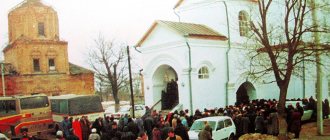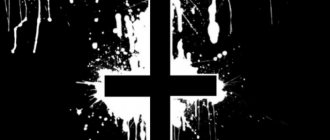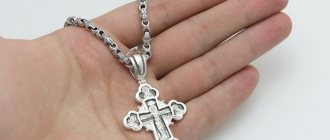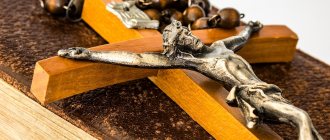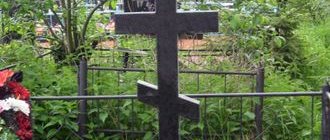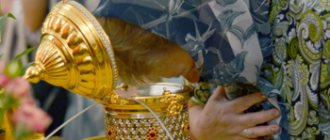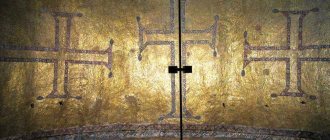Home > Information > Grave cross - a symbol of the Christian faith
Information
After the death of a Christian, a tombstone is placed over his burial mound, often in the form of a large cross or monument with a crucifix painted on the surface of the monument. A cross can also crown a tombstone. What does this sign mean in Christianity? Let's delve into the history of this creed to find out the true meaning.
Where do Orthodox Christians place a cross on their grave?
Immediately after the burial of the deceased, a grave cross is placed at the feet, since this indicates the prayerful mood of the buried Christian. This tradition has ancient origins and denotes the deceased’s commitment to the Christian faith.
Important! Cross of any shape, four-pointed, eight-pointed, etc. etc. are revered by the Orthodox equally as an instrument of the suffering of Jesus Christ and a guarantee of our salvation. But a tradition has developed that it is the eight-pointed cross that is placed on the grave of an Orthodox Christian after burial.
Why is it necessary to place a wooden cross on the grave after a funeral?
Death is an important, turning point in the existence of the human soul. Many people believe that life itself is just a preparation for meeting God. The cross is a symbol of such faith. Jesus Christ ascended to it and it marks the burials of all Orthodox Christians. Crosses are not placed on the graves of Muslims.
The grave, which did not have a cross, was previously avoided. The soul of the deceased, even if he were a righteous person, will not easily get to Heaven if it cannot pray one last time before the crucifixion. Saying goodbye to earthly existence and entering a better world after the Last Judgment, a person will take on the cross and thus emerge from the grave. The crucifix is a holy symbol of forgiveness.
There are countless superstitions associated with crucifixes placed on graves. Love spell, conspiracy, damage - all this can be brought on a person using a cross. But the church does not believe in this and does not approve of the desire of the Orthodox to protect themselves from damage with the help of special spells and slander. Salvation must be sought in prayers.
What should a grave cross look like?
There should be an eight-pointed cross over the grave of an Orthodox person, its symbolism is as follows:
- the actual crucifixion on which Jesus Christ was executed;
- a tablet above the head of Christ, where there was an inscription of the Lord’s “guilt” “Jesus Christ, King of the Jews”;
- in the lower part there is a slanting board indicating the path of Christ in the first three days after death and resurrection, His journey to hell to preach to sinners there too.
Priests recommend using a cross as a monument on a grave
This slanting tablet itself also served as a head for the Savior’s feet during the execution. The choice of this particular form of cross for the grave is understandable, since it truly corresponds to the reality of the death of the Son of God on the cross.
Origin and meaning of the crucifixion
The cross was endowed with a special meaning back in ancient times. Crossed lines have long been associated with ideas of space, space, and the intersections of life and death. This symbol is found in ancient drawings on the rocks of Central Asia, and on the slabs of Egyptian pyramids, and in Scandinavian and ancient Russian chronicles. Even on the boulders on Easter Island you can make out crosses.
It is interesting that in the Old Testament church among the Jews the cross was not used as an instrument of execution until the moment when, several decades before Christmas, the Romans crucified King Antigonus. Then the cross became a symbol of death and inspired horror in believers. However, Christ the Victor radically changed the meaning of the cross, making it a trophy over death, a sign of strength and power, evoking feelings of hope and joy.
During the first centuries of the existence of Christianity, adherents of the faith were forced to hide and conduct secret rituals. But with the rise of the Christian religion in the 8th century, Europeans began to widely use it in spiritual contexts. It was then that crosses began to be placed in cemeteries, believing that they sanctified the grave of the deceased.
Proportions and dimensions of the cross on the grave
Most often, a wooden cross is placed on the grave. Currently, this is justified, and manufacturers of such wooden products choose the best varieties of aspen, oak, cypress or pine. The trees are specially selected and prepared according to all the rules of carpentry. In addition, these blanks undergo special processing to increase the durability of the final product.
An eight-pointed cross is most often installed on graves.
The dimensions of the grave cross are based on the famous, eternal rules of the “golden section”; by observing them, you can actually create a completely proportional cross, without distortions and unnecessary ugly proportions. In order for the cross on the grave to be the correct size, you must adhere to the following rules:
- the cross bar is 1/3 of the height of the cross;
- its height is 1.7 meters, i.e. this is the average height of a person;
- the lower, inclined bar should not exceed 45 degrees.
In such proportions, the symbol of our salvation looks harmonious and beautiful. If these proportions are met, we truly see the beauty of the cross and prayerfully remember those who lie under its shadow.
Where to buy a ritual cross inexpensively?
“City Ritual Service” provides all necessary mourning attributes, including high-quality ritual crosses. These products are made of oak, pine, ash. To protect against moisture, bacteria and other negative factors, they are coated with a special compound. This is how the ritual cross retains its appearance for a long time. Thanks to this element, grieving relatives can easily find the burial place in the cemetery and honor the memory of the deceased person.
Advantages of purchasing ritual crosses from the City Ritual Service:
- wide range of models - you can choose the type of coating, church inscriptions and religious themes;
- neat appearance - the ritual attribute looks decent;
- loyal price - you can choose a product taking into account your financial capabilities;
- delivery throughout the region - we will quickly deliver the ritual attribute not only in Moscow, but also beyond its borders.
To purchase a ritual cross in the Moscow region with delivery, leave a request by phone. Specialists of the City Ritual Service will help you choose an inexpensive and high-quality ritual attribute.
What can crosses be made of?
The main material options for grave crosses, both historically and today, are wood and iron. They have different properties, different prices, and products made from them may be suitable for different situations. Let's take a closer look at them.
Tree
A cross made of wood is the most traditional way to mark a burial site. This is what people did in all centuries and in all cultures associated with Christianity: someone tied two branches and stuck them into the ground, someone ordered a cross from a skilled wood carver, but everyone knew that installing a wooden cross would adequately complete the funeral of the deceased. And today many of our compatriots follow this ancient tradition. Beautiful and durable crosses can be made from oak or pine, and some craftsmen can use larch or even ash, but in general, the choice of wood type can always be left to the customer. Only aspen, despite its strength and reliability, is used very rarely for grave crosses: this is due to superstition, which considers aspen to be a cursed tree, since, according to legend, it was on aspen that Judas, who betrayed Christ, hanged himself.
Wooden crosses on a grave have both their advantages and disadvantages, which are important to know about. Firstly, the use of wood involves a wide variety of types of finished products. Size, shape, thickness of individual elements, surface decoration - everything can be changed at the request of the customer. This material allows you to choose not only the appearance, but also its durability depending on the choice of wood species. The ability to choose the appropriate type of grave cross in accordance with the wishes and capabilities of the customer is a definite plus of wood.
Secondly, a high-quality wooden cross looks very elegant and neat. The greater ease of processing compared to metal and stone allows you to easily decorate the finished work with artistic carvings, inscriptions or patterns. This allows even a cross of a regular shape to acquire individuality and makes it more picturesque. Wood can also be painted and varnished - this will equally contribute to its decoration and increase its lifespan.
But it is precisely the lifespan of a wooden grave cross that should be mentioned separately. Unfortunately, the tree is short-lived. Despite all the advantages, wooden crosses are not suitable for people who want their tombstone to stand for years and decades. The strongest wood - even oak, even impregnated with special compounds - will deteriorate and collapse over time. Ten, twenty, thirty years - and the oak cross will have chips, the decor will collapse, and eventually the crossbars will break off. Competent and timely care of the grave can extend the life of a wooden cross, but we must be aware that most wooden crosses will lose their beautiful appearance within five years. If you want to leave a reliable, lasting memory of the deceased, a wooden cross is not suitable for you and you should consider other materials for making a tombstone.
Metal
Metal crosses are the second most common type of grave crosses after wooden ones. They are much more reliable than wooden crosses, although they are inferior in durability to granite or limestone tombstones. A metal cross can be created in two ways: forged from bent strips or welded from iron rods. Sometimes there are combined options, but in general you should know that a welded cross is cheaper than a forged one. Master blacksmiths can create a real work of art to order, but of course, this will not be cheap for the customer.
Metal crosses, like wooden ones, also have their advantages and disadvantages. Firstly, metal crosses are reliable. Although metal can suffer from rust and corrosion, even the simplest cheap cross welded from metal rods will last at least a decade. If you make a grave cross from high-quality steel and treat it with special coatings before installation, it will be many times more durable than a wooden cross. If you walk through old cemeteries today, even rural and abandoned ones, you can see a large number of metal crosses that were installed before the revolution - albeit rusty, sometimes bent, but completely intact and retaining their beauty. Therefore, many people are ready to limit themselves to a high-quality metal cross and do not install a stone tombstone at all.
Secondly, like wooden crosses, metal crosses can have varying complexity and cost. The customer has the right to decide for himself whether the grave will be decorated with a simple cross made of several pieces of iron or a real work of art. When burying a deceased person, a metal cross is sometimes installed as a temporary tombstone option, since it is much faster and easier to make than a stone memorial slab. Some people, however, make metal crosses as part of a complex composition of gravestone decorations.
Thirdly, metal crosses, as a rule, are quite simple structurally and visually. For metal crosses, small cross-section rods and not too thick strips of metal are used, so the final product is very airy and elegant. Some people like it, but many people believe that such a cross is only suitable as a temporary measure to decorate a grave, since it is completely devoid of the monumentality inherent in stone.
An important disadvantage of metal crosses is the possible threat from vandals.
The metal is highly valued, and the cross made from it is not too heavy, so, alas, it can be stolen by unscrupulous robbers. September 30, 2021
What parameters must be observed
Parameters that are usually followed when producing a tombstone crucifix:
- main bar (length) – 1.6 meters;
- additional cross bar (middle) – 1 meter;
- additional cross bars (upper and lower) – 0.38 meters;
- the distance between the top and the middle is 0.38 meters;
- another 0.5 meters retreat from the ground.
The top bar is attached parallel to the middle one, and the bottom one so that an angle of 45 degrees is obtained. The standard size of an Orthodox cross (cm) is 70:40:5 or 120:60:8.
To create a Catholic crucifix, the main plank is divided into 3 equal parts. Each crossbar has a length equal to 1/3 of the length of the entire column. The width is chosen by eye. But the design looks better if all the planks are the same.

